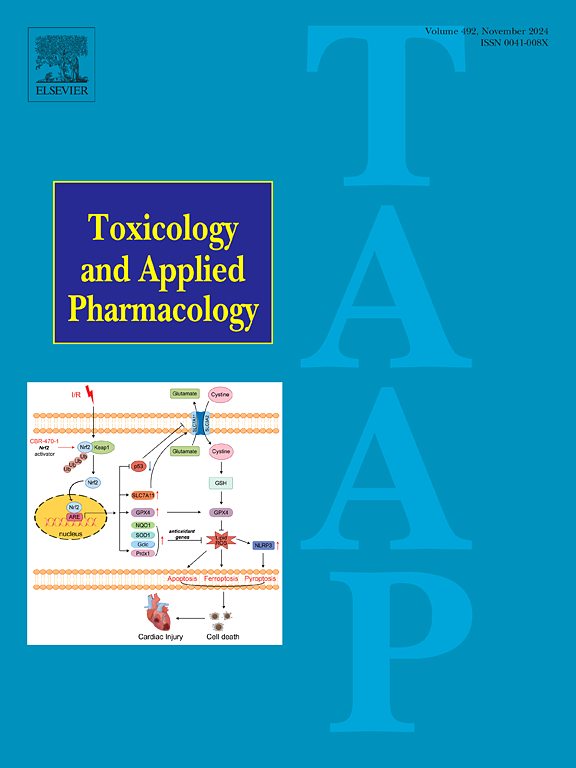雷公藤酚内酯通过破坏肠道生物功能加重雷公藤甲素引起的肝损伤
IF 3.4
3区 医学
Q2 PHARMACOLOGY & PHARMACY
引用次数: 0
摘要
雷公藤(雷公藤)在传统中医中被用于治疗类风湿关节炎、肾炎和红斑狼疮等疾病。然而,对肝脏的毒性反应对TW的临床应用构成了巨大的障碍。TW的毒理学机制尚不清楚。以雄性C57BL/6小鼠为研究对象,分别单独或联合给予雷公藤甲素(TP)和雷公藤酚内酯(TPH)对肝脏的影响。Elisa检测血浆中与肝损伤相关的LPS。采用代谢组学和16S rRNA分析研究可能导致肝损伤的肠功能紊乱相关病理标志物。对差异代谢物与变化菌群进行相关性分析,寻找基本代谢分子,并通过添加体内代谢物验证相关性分析结果。TPH与TP同时使用可引起肠道出血和微生物生态失调,进而增加血浆LPS水平,使TP引起的肝损害更加严重。代谢组学分析和菌群组成变化证明,毒性代谢物PCS与肠道屏障损伤显著相关,联合给药时PCS的添加促进了肝毒性。通过增加PCS, TPH破坏肠道屏障,增加循环LPS,激活肝脏TLR4/MyD88通路,从而加剧tp诱导的肝损伤。本文章由计算机程序翻译,如有差异,请以英文原文为准。

Triptophenolide aggravates triptolide-induced liver injury through disrupting the biological function of intestine
Tripterygium wilfordii, Hook f. (TW) has been traditionally used in Chinese medicine to treat conditions like rheumatoid arthritis, nephritis, and lupus erythematosus. However, the toxic reactions to the liver pose a huge obstacle to TW's clinical applications. The toxicological mechanisms of TW remain unclear. Male C57BL/6 mice were administered with TW ingredient triptolide (TP) and triptophenolide (TPH) alone or in combination to investigate their individual and synergistic effects on the liver. Elisa tested for LPS in the plasma correlated with liver injury. Metabolomics and 16S rRNA analysis were used to investigate pathological markers associated with intestine function disorder which may contribute to liver injury. The correlation analysis between the differential metabolites and the changing flora was carried out to find the fundamental metabolic molecules, and the results of the correlation analysis were verified by the addition of metabolites in vivo. The concurrent use of TPH and TP cause intestinal bleeding and microbial dysbiosis, then augment level of LPS in the plasma to prompting more severe liver damage induced by TP. Metabolomic analysis and changes in microflora composition proved that the toxic metabolite PCS was significantly related to intestinal barrier damage, and the addition of PCS promoted hepatotoxicity in combination administration. By augmenting PCS, TPH compromises the gut barrier, escalates circulating LPS, and activates the hepatic TLR4/MyD88 pathway, thereby exacerbating TP-induced hepatic injury.
求助全文
通过发布文献求助,成功后即可免费获取论文全文。
去求助
来源期刊
CiteScore
6.80
自引率
2.60%
发文量
309
审稿时长
32 days
期刊介绍:
Toxicology and Applied Pharmacology publishes original scientific research of relevance to animals or humans pertaining to the action of chemicals, drugs, or chemically-defined natural products.
Regular articles address mechanistic approaches to physiological, pharmacologic, biochemical, cellular, or molecular understanding of toxicologic/pathologic lesions and to methods used to describe these responses. Safety Science articles address outstanding state-of-the-art preclinical and human translational characterization of drug and chemical safety employing cutting-edge science. Highly significant Regulatory Safety Science articles will also be considered in this category. Papers concerned with alternatives to the use of experimental animals are encouraged.
Short articles report on high impact studies of broad interest to readers of TAAP that would benefit from rapid publication. These articles should contain no more than a combined total of four figures and tables. Authors should include in their cover letter the justification for consideration of their manuscript as a short article.

 求助内容:
求助内容: 应助结果提醒方式:
应助结果提醒方式:


